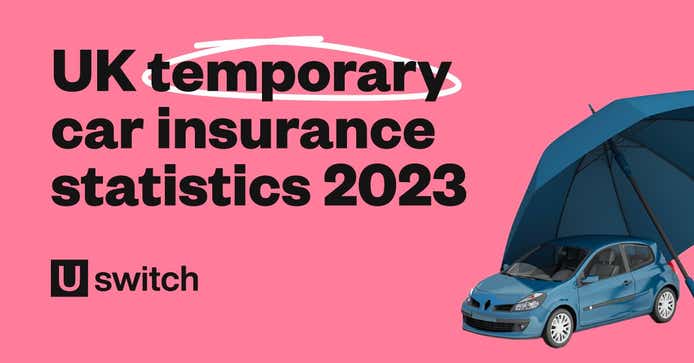The UK commercial motor insurance market was worth around £5.65 billion in 2022 and is expected to record a compound annual growth rate (CAGR) of 4% between 2023-27.
However, according to the Van Insurance Price Index, quoted van insurance prices rose by more than a third (35.9%) in 2023 – the biggest annual increase since 2017.
The Uswitch van statistics page for 2024 covers how the UK van insurance market has recently changed in terms of how many vans there are in the UK and which are the most popular. It also explores the UK average cost of van insurance and the varying factors that influence this, such as van theft statistics.
Top 10 UK van statistics 2024
Almost 53,000 vans were registered in the UK in March 2024, with the most common weight (2.5 - 3.5t) accounting for more than two-thirds (67.26%) of registrations for the month.
Ford is the most popular brand of van in the UK for vans weighing less than 3.5t and those between 3.5 - 6.0t (accounting for 34.27% and 29.28% of respective registrations for March 2024).
Around one in five (22%) vehicles on UK roads is a van.
As of 2022, there were 57.5 billion miles driven by vans in the UK – a 5.7% increase from 2021.
In Q3 2023, there were 15.6 billion miles recorded by light commercial vehicles (LCVs), representing approximately a fifth (18.1%) of total UK vehicle miles for the quarter.
The average annual mileage of van drivers was 8,232 between March 2023 and March 2024.
Research by Consumer Intelligence suggests the average cost of van insurance in the UK is between £500 and £999.
According to the Van Insurance Price Index, the average price of van insurance rose by more than a third (35.9%) between 2022-23.
Around one in three (35%) drivers aged 25-and-under could get a van insurance quote for less than £1,500 in 2023-24, compared to 97% for the over-50s.
Drivers using their van for social use only received an average van insurance quote of £432.32 – typically four times cheaper than those using their vehicle for business haulage.
UK van market statistics
How many vans are in the UK?
In March 2024, there were almost 53,000 vans registered in the UK that were less than 3.5t. The most common weight of vans in the UK for the month were those between 2.5 - 3.5t, accounting for more than two-thirds (67.26%) of all vans registered in March 2024.
Rigid vans (>3.5 - 6.0t) were the UK's least common van type as of March 2024. With less than a thousand registered throughout the month, this accounted for 1.79% of the total UK van market. Yet, their numbers have increased by almost 46% compared to 12 months earlier – the largest percentage increase across all UK van types.
A breakdown of how many vans are in the UK (March 2024 vs. March 2023)

| Type of van | March 2023 | March 2024 | % change |
|---|---|---|---|
| Pickups | 5,762 | 5,767 | 0.09% |
| 4x4s | 1,264 | 1,632 | 29.11% |
| Vans <=2.0t | 681 | 986 | 44.79% |
| Vans > 2.0 - 2.5t | 9,276 | 8,939 | -3.63% |
| Vans > 2.5 - 3.5t | 30,651 | 35,592 | 16.12% |
| All vans to 3.5t | 47,634 | 52,916 | 11.09% |
| Rigids > 3.5 - 6.0t | 648 | 946 | 45.99% |
(Source: SMMT)
Van statistics from the SMMT reveal that the number of 4x4 vehicles in the UK increased by almost a third (29.11%) between March 2023 and March 2024. This represents just over 3% of the total UK van market.
Incidentally, vans between 2 - 2.5t were the second most common type of van in the UK as of March 2024, constituting around a sixth (16.89%) of all UK vans. However, this was the only type of van that saw a decrease in registration numbers compared to March 2023 (3.63%).
A breakdown of how many vans are in the UK year-to-date (2023 vs 2024)

| Type of van | YTD (2023) | YTD (2024) | % change |
|---|---|---|---|
| Pickups | 9,864 | 10,664 | 8.11% |
| 4x4s | 1,858 | 2,663 | 43.33% |
| Vans <=2.0t | 1,466 | 1,613 | 10.03% |
| Vans > 2.0 - 2.5t | 15,770 | 17,141 | 8.69% |
| Vans > 2.5 - 3.5t | 58,314 | 62,731 | 7.54% |
| All vans to 3.5t | 87,272 | 94,812 | 8.64% |
| Rigids > 3.5 - 6.0t | 1,245 | 1,990 | 59.84% |
(Source: SMMT)
In the year-to-date (YTD) for March 2024, there were 94,812 vans registered in the UK – an 8.64% increase from the same time point last year.
Two-thirds (66.16%) of these were vans between 2.5 - 3.5t in weight, making them the most popular van in the UK for 2024. This was followed by those weighing 2.0 - 2.5t, which accounts for less than a fifth (18.08%) of the total UK van population.
Rigid vans (i.e. those between 3.5 - 6.0t) saw the biggest increase between 2023-24, rising by almost three-fifths (59.84%). Yet, they account for just 2% of all vans registered in the UK – the second-least popular type of van behind those under 2.0t in weight (1.7%).
Most popular vans in the UK
According to van market statistics from the SMMT, Ford is the most popular brand of van in the UK weighing less than 3.5t. There were 18,132 Ford vans registered in March 2024 for this weight category. This accounted for just over a third (34.27%) of the total UK van population and represented a 15.42% increase on March 2023 figures.
By contrast, around one in ten (10.61%) UK vans registered under 3.5t in March 2024 were Volkswagen, making them the second most popular brand of van in the UK for the month for this category.
A breakdown of most popular vans in the UK (< 3.5t) (March 2023 vs March 2024)

| Marque | March 2023 | % of total | March 2024 | % of total | % change |
|---|---|---|---|---|---|
| Ford | 15,710 | 32.98 | 18,132 | 34.27 | 15.42 |
| Volkswagen | 4,821 | 10.12 | 5,617 | 10.61 | 16.51 |
| Vauxhall | 3,800 | 7.98 | 4,354 | 8.23 | 14.58 |
| Citroën | 4,419 | 9.28 | 4,258 | 8.05 | -3.64 |
| Peugeot | 3,258 | 6.84 | 3,831 | 7.24 | 17.59 |
| Renault | 3,321 | 6.97 | 3,826 | 7.23 | 15.21 |
| Toyota | 2,730 | 5.73 | 2,906 | 5.49 | 6.45 |
| Mercedes | 2,823 | 5.93 | 2,702 | 5.11 | -4.29 |
| Fiat | 1,040 | 2.18 | 1,306 | 2.47 | 25.58 |
| Landrover | 1,061 | 2.23 | 1,267 | 2.39 | 19.42 |
| Other | 4,651 | 9.76 | 4,717 | 8.92 | 1.42 |
| Total | 47,634 | 100 | 52,916 | 100 | 11.09 |
(Source: SMMT)
On average, there were around 11% more vans registered in the UK in March 2024 compared to 12 months earlier.
There were four times (+25.58%) more Fiat vans in the UK in March 2024 compared to March 2023 – the largest percentage increase of all van makes for this period.
A breakdown of most popular vans in the UK (< 3.5t) year-to-date (2023 vs 2024)

| Marque | YTD (2023) | % of total | YTD (2024) | % of total | % change |
|---|---|---|---|---|---|
| Ford | 28,413 | 32.56 | 29,856 | 31.49 | 5.08 |
| Volkswagen | 8,764 | 10.04 | 9,842 | 10.38 | 12.3 |
| Vauxhall | 7,728 | 8.86 | 8,701 | 9.18 | 12.59 |
| Citroën | 7,546 | 8.65 | 7,826 | 8.25 | 3.71 |
| Peugeot | 6,006 | 6.88 | 6,440 | 6.79 | 7.23 |
| Renault | 6,859 | 7.86 | 6,377 | 6.73 | -7.03 |
| Toyota | 4,873 | 5.58 | 6,285 | 6.63 | 28.98 |
| Mercedes | 5,429 | 6.22 | 5,889 | 6.21 | 8.47 |
| Fiat | 1,918 | 2.2 | 2,418 | 2.55 | 26.07 |
| Nissan | 1,914 | 2.19 | 2,016 | 2.13 | 5.33 |
| Other | 7,822 | 8.96 | 9,162 | 9.65 | 17.13 |
| Total | 87,272 | 100 | 94,812 | 100 | 8.64 |
(Source: SMMT)
In the YTD 2024, Ford is the most common make of van in the UK weighing less than 3.5t, according to SMMT van registration statistics. In Q1 2024, there were almost 30,000 Ford vans registered in the UK for this weight category, accounting for just under a third (31.49%) of the total UK van market.
Compared to 2023 respective figures, Toyota saw the biggest increase in van registration numbers for those weighing less than 3.5t, rising by more than a quarter (+28.98%). Yet, they accounted for just 6.63% of the overall total for Q1 2024.
Overall, there were almost 9% more vans registered in the UK during Q1 2024 compared to Q1 2023.
A breakdown of most popular vans in the UK (> 3.5t - < 6.0t) (March 2023 vs March 2024)

| Marque | March 2023 | % of total | March 2024 | % of total | % change |
|---|---|---|---|---|---|
| Ford | 158 | 24.38 | 277 | 29.28 | 75.32 |
| Fiat | 120 | 18.52 | 246 | 26 | 105 |
| Mercedes | 255 | 39.35 | 177 | 18.71 | -30.59 |
| Peugeot | 39 | 6.02 | 134 | 14.16 | 243.59 |
| Iveco | 18 | 2.78 | 29 | 3.07 | 61.11 |
| Man | 0 | 0 | 20 | 2.11 | 0 |
| Citroën | 8 | 1.23 | 19 | 2.01 | 137.5 |
| Vauxhall | 8 | 1.23 | 10 | 1.06 | 25 |
| Volkswagen | 3 | 0.46 | 17 | 1.8 | 466.67 |
| Maxus | 34 | 5.25 | 13 | 1.37 | -61.76 |
| Other | 5 | 0.77 | 4 | 0.43 | -20 |
| Total | 648 | 100 | 946 | 100 | 45.99 |
(Source: SMMT)
As of March 2024, the most popular make of van in the UK between 3.5 - 6.0t in weight was Ford. There were 277 registered in the UK during this month, accounting for just under a third (29.28%) of the overall total.
This was followed closely by Fiat at 246 registrations for the month, or just over a quarter (26%) of the UK van market for March 2024.
In total, this means over half (55%) of all vans between 3.5 - 6.0t registered in the UK for March 2024 were either Ford or Fiat.
In terms of percentage increase, there were 17 registered Volkswagen vans in the UK in March 2024 – an increase of 466% from 12 months earlier. This represented the largest increase across all makes of van in the UK for this weight category.
A breakdown of most popular vans in the UK (> 3.5t - < 6.0t) year-to-date (2023 vs 2024)

| Marque | YTD (2023) | % of total | YTD (2024) | % of total | % change |
|---|---|---|---|---|---|
| Ford | 282 | 22.65 | 560 | 28.14 | 98.58 |
| Fiat | 265 | 21.29 | 455 | 22.86 | 71.7 |
| Mercedes | 434 | 34.86 | 389 | 19.55 | -10.37 |
| Peugeot | 86 | 6.91 | 243 | 12.21 | 182.56 |
| Iveco | 58 | 4.66 | 144 | 7.24 | 148.28 |
| Man | 0 | 0 | 61 | 3.07 | 0 |
| Citroën | 22 | 1.77 | 41 | 2.06 | 86.36 |
| Vauxhall | 27 | 2.17 | 39 | 1.96 | 44.44 |
| Volkswagen | 5 | 0.4 | 25 | 1.26 | 400 |
| Maxus | 58 | 4.66 | 24 | 1.21 | -58.62 |
| Other | 8 | 0.64 | 9 | 0.45 | 12.5 |
| Total | 1,245 | 100 | 1,990 | 100 | 59.84 |
(Source: SMMT)
As of Q1 2024, Ford was the most popular make of van weighing between 3.5 - 6.0t. With 560 UK registrations between January and March 2024, this accounted for more than a quarter (28.14%) of all vans registered during this period and almost double (+98.58%) compared to Q1 2023.
By contrast, Fiat was the second most popular make of van in the UK for this category in Q1 2024, accounting for just over a fifth (22.86%) of the total van population for this quarter.
Van statistics from the SMMT show that, on average, there were around three-fifths (59.84%) more vans registered in Q1 2024 weighing 3.5 - 6.0t compared to the same time in 2023. Overall, quarterly registration figures during this period also dropped from 1,245 to 1,990, respectively.
UK van traffic statistics
As of 2022, vans accounted for more than a fifth (22%) of UK traffic, making them the second most common type of vehicle on UK roads.
A breakdown of road traffic statistics in the UK by vehicle type

Road traffic statistics from the Department for Transport (DfT) indicate that cars are the most common vehicle in the UK, accounting for around three-quarters (75%) of UK traffic figures.
A breakdown of UK van traffic statistics over time (1993-2022)

Van traffic statistics from the Department for Transport (DfT) suggest that there were around 57.5 billion vehicle miles driven by UK vans in 2022. This represents a 5.7% increase from 2021 figures and a rise of almost a fifth (+18.3%) from 2020, during which the COVID-19 pandemic caused a significant reduction in the number of vehicles on the road.
The annual number of vehicle miles by UK vans has generally risen year-on-year since 1993. During this time, the total number of vehicle miles by vans in the UK has more than doubled (+122.8%).
Total number of miles covered by vans in the UK
The total number of miles covered by UK vans (i.e. light commercial vehicles, or LCVs) in Q3 2023 was 15.6 billion. This represented just under a fifth (18.1%) of the total UK vehicle miles for the quarter (86.4 billion) and amounted to a 2% rise from Q2 2023 when the respective figure stood at 15.2 billion.
A breakdown of UK road traffic statistics by vehicle type (2018-23)

The number of miles covered by UK vans has generally risen quarter-on-quarter since 2018, save for a short dip during Q2 2020 largely thanks to the Covid pandemic. In 2018, there were 12.4 billion registered miles by UK vans for the first quarter of the year – a 15% rise compared to the same time five years later.
The average annual mileage of van insurance customers was 8,283 (between March 2023 and March 2024) according to quote data analysed.
A breakdown of the rolling quarterly percentage change to UK road traffic statistics by vehicle type

In terms of the quarterly rolling percentage change in UK van traffic statistics, Q3 2023 saw a 3.9% increase in the number of van miles compared to Q2.
The largest monthly percentage increase in UK van miles from 2018-23 was seen between Q4 2021 and Q1 2022 when the figure increased by more than a fifth (20.1%). The Covid pandemic caused quarterly percentage change figures to drop by as much as 12.5% in Q1 2021 (compared to Q4 2020). However, by Q2 2021, this figure had bounced back to +6%, by comparison.
A breakdown of the rolling quarterly percentage change to UK van traffic statistics by road type (2018-23)

When broken down by road type, there were around 5.4% more miles completed by vans on UK motorways in Q3 2023 than in the previous quarter. This represented the largest percentage increase across all UK road types for the quarter. Incidentally, minor urban roads were the only UK road type to register a drop in van traffic miles for Q3 2023 (-0.7%) compared to Q2 2022.
Q1 2022 saw the largest quarterly percentage increase in UK van miles between 2018-23 across all road types. This ranged from more than a quarter increase (25.8%) on UK motorways down to +14.9% for minor urban roads.
By contrast, major rural ‘A’ roads experienced the largest quarterly decrease during this period, falling by 14.6% in Q1 2021.
A breakdown of road traffic statistics by vehicle type across UK regions (2022)

As of 2022, there were around 48.16 billion vehicle miles completed by light goods vehicles (LGVs) in the UK. Around a fifth (19.1%) of these were done in the South East, making it the most popular UK region for van miles in 2022.
This was followed by the East of England and South West, which contributed 14.4% and 12.8% respectively to the overall total for 2022.
Conversely, the fewest number of van miles in 2022 took place in London (648.6 million), followed by Wales (681.3 million), accounting respectively for 1.3% and 1.4% of the overall total for the year. This means, as of 2022, there were around 14 times more van miles in the South East compared to London.
UK average van insurance cost statistics
According to the Van Insurance Price Index, the quoted average price of van insurance in the UK increased by more than a third (35.9%) between 2022-23, representing the largest annual rise since 2017.
The longer-term picture shows that average van insurance quotes in the UK have nearly trebled since 2014 – a rise of +192.4% within 10 years.

However, the quarterly increase for Q4 2023 dropped to +4% compared with +12.9% for Q3 and +9.8% for Q2.
The van insurance study from Consumer Intelligence highlights that, in December 2023, more than a third (36%) of van drivers received a quote between £500-£999 for their van insurance – the most commonly quoted price throughout the year. In addition, around 15% of van drivers received quotes between £1,000 and £1,249, while just 10% obtained a quote under £500.
Temporary van insurance is also available should you wish to drive a van for a short period and you’re not covered on an existing policy to drive it, or you want to ensure you have fully comprehensive cover as opposed to third-party.
Average cost of van insurance in the UK by age
According to the Van Insurance Index, around a third (35%) of young drivers in 2023 (i.e. those aged 25 and under) could find a quote below £1,500 for van insurance, compared with 87% for 25-49-year-olds and 97% for the over-50s.
The study from Consumer Intelligence also highlights:
Young drivers experienced a slower rise in quoted premiums for 2023 at just over a quarter (+24.5%) compared with more than two-fifths (+41.6%) for the over-50s and more than a third (+36.6%) for those between 25-49.
Just 15% of van drivers under 25 in 2023 could get an insurance quote below £1,000. This is contrasted by two-thirds (66%) of those aged 25-49 and 89% for the over-50s.
Around two-fifths (42%) of van drivers over 50 could obtain a van insurance quote for less than £500 compared with 15% for 25-49-year-olds and 0% for the under-25s.
Average cost of van insurance in the UK by type of insurance
Business premium van insurance is the cheapest type of van insurance, with an average quote of £585.03 in 2023-24, according to data analysed from Confused.com.
A breakdown of quoted average van insurance cost by type of insurance

Van insurance statistics suggest a typical UK van driver opting for business premium insurance could pay around a quarter less (25.41%) per year on their average insurance cost compared to those who opt for an EV premium policy.
In addition, those customers who selected an annual van insurance policy typically saved around 15.92% on their average van insurance cost compared to those who chose to pay monthly.
Average cost of van insurance in the UK by type of usage
The average cost of van insurance for someone using their van for social use only was £432.32 – the cheapest average quote across all types of usage, according to data analysed from Confused.com between March 2023 and March 2024.
A breakdown of quoted average van insurance cost by type of usage

This was around a fifth (20.47%) cheaper than those using their van for social commuting and more than a quarter (26.69%) less than a typical van driver using their vehicle for business use to carry personal goods.
On average, UK van insurance statistics suggest those using a van for business use and haulage can expect to pay around four times more for their van insurance compared to social-only usage.
According to the Van Insurance Index, van drivers using their vehicles for social, domestic, and pleasure (SDP) saw their average van insurance premiums rise by more than a third (37.6%) in 2023. The respective figure for tradespeople (i.e. those carrying their goods) stood at +35.3% for the same period.
You may want to consider goods in transit insurance. This can help financially cover you against the loss, damage, or theft of any stock, materials, or tools you transport as part of your business.
Average cost of van insurance in the UK by number of cover days remaining
Generally speaking, the fewer days you have remaining on your existing van insurance policy, the more expensive your renewal quote will be.
Van insurance policy holders who renewed once their existing policy had expired, paid on average 6% more than those who renewed one day earlier, paying on average £661.28 (according to Confused.com data analysed from March 2023 - March 2024).
A breakdown of quoted average van insurance cost by number of cover days remaining

| Number of cover days remaining on policy | Median average cost of van insurance (£) |
|---|---|
| 0 | £661.28 |
| 1 | £621.55 |
| 2 | £555.37 |
| 20 | £344.95 |
| 22 | £356.22 |
| 23 | £356.24 |
(Source: Confused.com)
Those with 20 days remaining on their van insurance were typically quoted the lowest price, with an average cost of £555.37 – almost a fifth (17.41%) less than those with no days remaining.
UK van theft statistics
According to DVLA van theft statistics obtained by Vanarama, there were 12,950 vans reported stolen in the UK throughout 2023. This represented a rise of a fifth (18%) from 2022 figures.
By comparison, there were more than double (+132.76%) the amount of reported car thefts in 2023. The overall figure for UK cars stolen during 2023 was 64,087 – a 5% rise from the previous year.
Despite the relatively small numbers, the reported rise over the last 12 months is an indication that UK van owners are increasingly becoming the victim of targeted criminal activity.
What are the most commonly stolen vans in the UK?
A study by Vanarama into reported van theft statistics found that, of the 15 most commonly stolen UK vans of 2023, there were 4,534 reported thefts across the year.
Of these, the most commonly stolen van of 2023 was the Mercedes-Benz Sprinter 313 CDI, accounting for just over a fifth (20.69%) of vans reported stolen throughout the year. This was followed by the Mercedes-Benz Sprinter 314 CDI, which was responsible for 14.56% of reported van thefts for 2023 – around a third more than the 313 CDI model.
A breakdown of the most commonly stolen vans in the UK (2023)

Of the 15 most commonly stolen vans in the UK for 2023, 12 of them (80%) were Ford. This amounted to 2,790 reported van thefts across the year, meaning roughly three in every five (61.53%) UK vans reported stolen in 2023 belonged to Ford.
When are vans most likely to get stolen in the UK?
According to the van theft data obtained by Vanarama, there were 1,263 vans reported stolen in March 2023 – 8% more than the next highest month (January) with 1,165. Darker evenings during the winter may lead to this, as well as the release of new registrations in March, which may increase the risk of criminal activity.
This is contrasted by 932 thefts in June 2023 – more than a third (35%) less than March by comparison. This may highlight the fact that lighter evenings become a deterrent for potential criminals as they would be seen more easily.
For more information, check out our car insurance guides for an extensive range of topics related to cars and other motor vehicles, including vans.
UK van statistics FAQs
What is van insurance?
Van insurance helps to protect you financially if your van is involved in an accident, is stolen, or becomes damaged. It can also help cover the cost if you injure someone else or damage their property/vehicle with your van.
What is commercial van insurance?
Commercial van insurance is a type of insurance taken out for a van that you use for work purposes, including commuting. Sometimes referred to as business van insurance, it can also provide cover for your personal and professional possessions (such as tools), as well as the transportation of goods and materials should they become damaged, stolen, or destroyed.
Is van insurance more expensive?
Generally speaking, yes. Vans can be more expensive to insure compared to other road vehicles.
How much is van insurance?
A study from Consumer Intelligence found that, in December 2023, more than a third (36%) of van drivers were quoted between £500-£999 for their van insurance – the most commonly quoted price for the year. On average, the average cost of van insurance rose by more than a third (35.9%) between 2022 and 2023.
Why is van insurance so expensive?
Van insurance can be more expensive compared to other vehicles for several reasons. Vans are normally larger and have more powerful engines, which may increase the risk of crashing for unskilled drivers. Plus, they’re generally more expensive to repair. Insurers tend to perceive work vans as higher risk, due to the fact they’re likely to drive more miles per year compared to cars. They also tend to store tools and materials, which is appealing for potential criminal activity and further increases the risk factor.
Why is van insurance so expensive for young drivers?
Van insurance tends to be more expensive for younger drivers as they are less experienced and statistically pose a higher risk. Young drivers are also less likely to have a clean, no-claims bonus (NCB) history, which keeps van insurance premiums high until they can display a proven track record of competent driving.
A young driver is generally classified as someone under the age of 25 who has passed their driving test. However, some insurers impose minimum age limits for van insurance. So, if you’re under 21, you may find you’re offered less competitive prices for your van insurance. Therefore, it’s worth shopping around to find the best deal for you.
Why has van insurance gone up?
Van insurance has gone up in recent years due to several factors. The cost of living crisis has seen a rise in the average cost of repairs and labour. It’s estimated that insurers paid around 10% more on claims in 2022 compared to the money made from premiums, hence why a further increase in claims in 2023 has led to a rise in the average cost of van insurance.
Fleet News claims that there were over 631,000 pothole-related incidents reported in 2023 – the highest figure in five years and further increases the pressure on the van insurance industry. Vans also tend to have more complex components compared to other vehicles.
The rise of electric vans, for example, means replacement parts can be more expensive and harder to source, further increasing the cost for insurance companies and consumers.
What is the cheapest van insurance?
The cheapest van insurance tends to be for drivers using their van for social use only, with an average quote cost of £432.32 (according to Confused.com data analysed from March 2023 - March 2024).
How to get cheap van insurance in the UK
Just like cutting the cost of your car insurance, there are many ways in which you can get cheaper van insurance in the UK. Here are just some of the ways that you can do it:
Consider the size of your van - Smaller vans tend to be cheaper to insure as they have smaller engines and are less powerful. So, insurers generally classify them as a lower risk.
Compare different types of van insurance - Your van insurance costs can vary depending on whether you select third-party only, third-party fire and theft, or a fully comprehensive policy. However, the cheapest doesn’t always equal the best, so make sure you select a policy that provides you with adequate coverage.
Select the right payment method - Annual payments tend to be cheaper than paying monthly for van insurance.
Make sure your work status and van usage are accurate - Consider the purpose of your van (commuting, transporting goods) as well as your job description as this can affect your premiums. Just remember to be honest - if not, you could invalidate your policy.
Consider adding van security features - Alarms, trackers, and immobilisers can help bring the cost of your van insurance down.
What insurance group is my van?
Van insurance groups are categorised by the Association of British Insurers (ABI) based on their levels of relative risk. Every make and model of a van in the UK is assigned to an insurance group, of which there are 50 in total. Generally speaking, the lower the group your van is in, the less your van insurance should cost.
You can check which insurance group your van is in before buying it, so you can see what the van insurance prices might be like if you went ahead with the purchase.
Vans produced before 2016 are put in groups one to 20. Those produced after 2016 are put into groups 21-50. However, van insurance should not be purchased solely based on which group it falls into – this is only a guide and just one factor that can help determine the final cost of your van insurance.
When does my van insurance run out?
Much like car insurance, there are many ways you can check when your van insurance runs out:
Look for your van insurance renewal date on your policy documents or van insurance certificate.
Contact your provider and ask them directly or sign into your online van insurance account with them.
Review your bank statements to track when your first payment date was.
How do I find out who my van insurance is with?
You can find out who your van insurance is with using a variety of different methods:
Check your emails for a confirmation email from an insurance provider containing policy details.
Check your bank statements within the last year as your insurer should appear whether you pay monthly by direct debit or made an annual payment when you took out the policy.
Check your paperwork as some insurers send hard copies of your policy documents through the post.
You can also visit askMID.com (a motor insurance database) for free to check if your vehicle is insured.
UK van statistics glossary
Heavy Goods Vehicle (HGV)
A vehicle weighing more than 3.5 tonnes (or 3,500kg), including cargo. Also known as a large goods vehicle (LGV). This can include vehicles such as fridge trucks, tippers, drop sides, and Lutons.
Light Commercial Vehicles (LCV)
A vehicle used for the transportation of goods that has a maximum weight of 3.5 tonnes (or 3,500kg), including cargo. This can include vehicles such as vans, pick-up trucks, and three-wheelers.
Marque
The make of a vehicle, such as Ford, Volkswagen, or BMW, as opposed to a specific model.
Pickup van
A light or medium-duty vehicle tends to have an enclosed cabin for the driver and passengers, with an open part at the back in which to transport cargo.
Rigid van
A large, non-articulated vehicle where the cargo-carrying body section is permanently attached to the main chassis/cabin where the driver sits. As this vehicle is rigid, it can’t bend along its length nor does it have a separate trailer that can be detached, unlike articulated HGVs.
Vehicle miles
The total number of miles driven by a vehicle over a defined geographical region within a specific time frame (usually a year).
Sources and methodology
https://www.globaldata.com/store/report/uk-commercial-motor-insurance-market-analysis/
https://www.consumerintelligence.com/van-insurance-price-index-download
https://www.smmt.co.uk/vehicle-data/lcv-registrations/
https://roadtraffic.dft.gov.uk/summary
https://www.gov.uk/government/statistical-data-sets/tra25-quarterly-estimates
https://roadtraffic.dft.gov.uk/downloads
https://www.consumerintelligence.com/articles/van-insurance-accelerates-by-15.5-in-the-past-year
https://businessvans.co.uk/van-news/the-most-stolen-vans-and-how-to-keep-yours-safe/
Van insurance quote data taken from Confused.com internal sources collected on behalf of Uswitch (March 2023 and March 2024)








